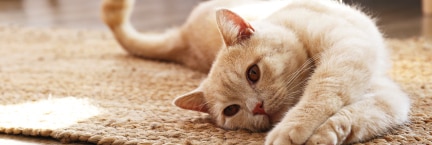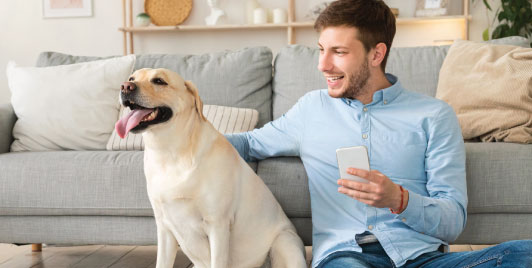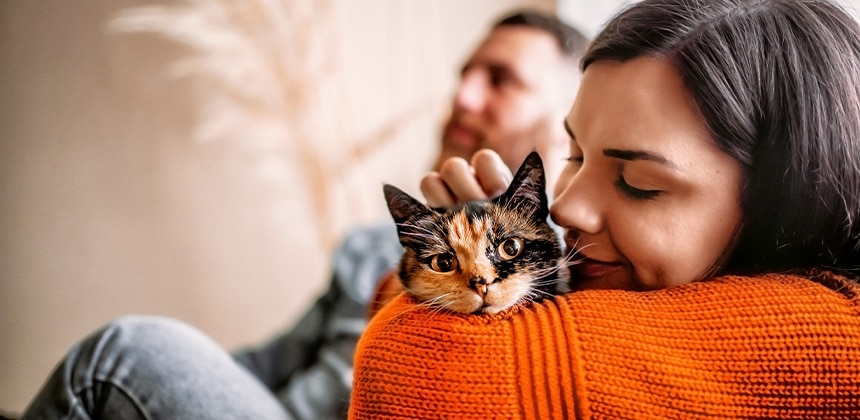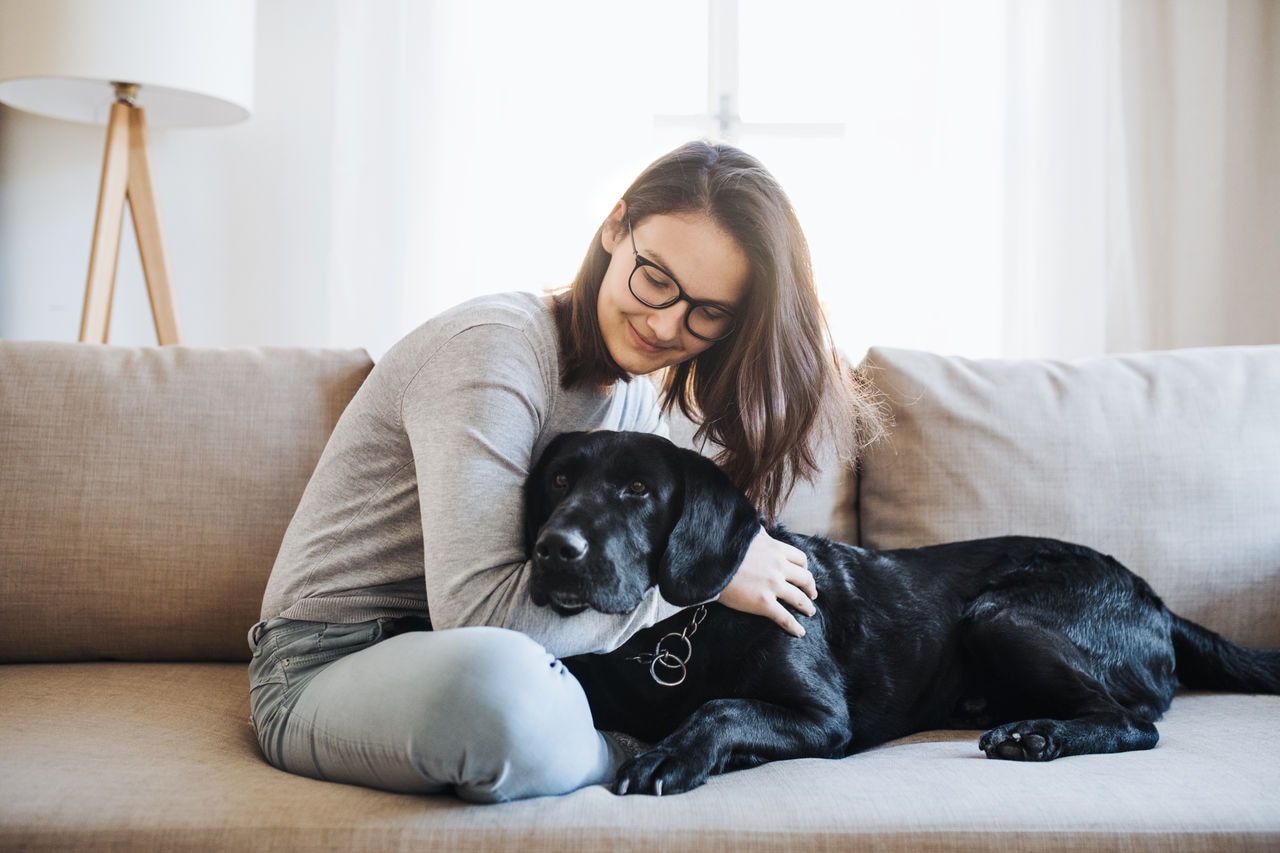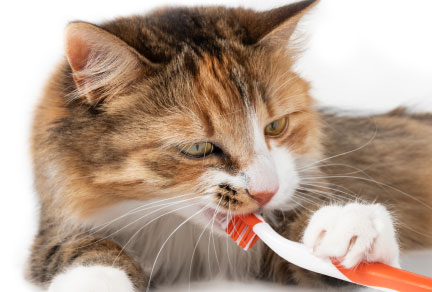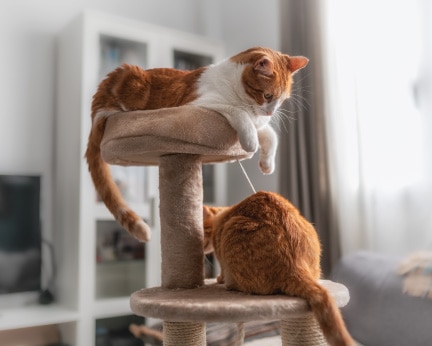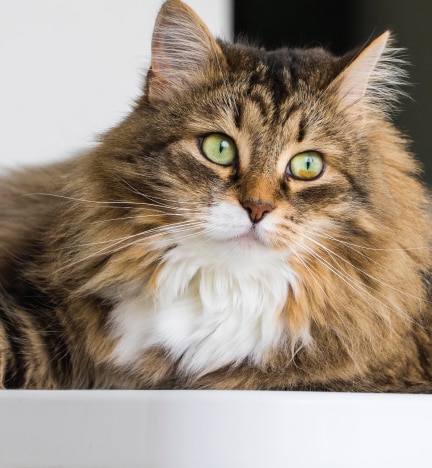- text
-
° This offer is only available for policyholders who have a registered Everyday Rewards Card linked to their eligible active Everyday Insurance policy. This offer is limited to one in-store Woolworths Supermarket transaction up to $500, with a maximum saving of $50 per Everyday Rewards Card, per month, regardless of the number of Woolworths services you use. For full T&Cs click here.
Feline obesity.
A silent epidemic.
Pet Insurance | 5 minute read | 7 August 2025
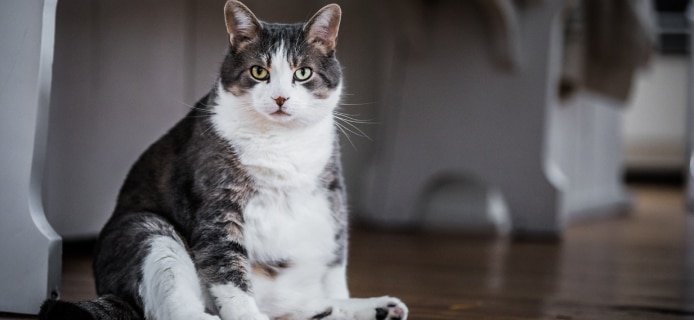
Once a relatively uncommon issue, feline obesity now affects a significant percentage of domestic cats. According to PetSure claims data (Jan 2020 to Dec 2024), the percentage of cats classified as overweight or obese ranges from 17% to 53% depending on age. The lowest percentage occurs in the first year of life at 17% but more than doubles by the second year to 37% and only increases from there. The highest percentage occurs for cats aged 7 to 8 years old with 53% of this age bracket classified as overweight or obese.
This data tallies with the most recent Animal Medicines Australia (AMA) 'Pets in Australia' report (2022) which estimates that approximately 41% of cats are classified as overweight or obese. However, this figure increases to 61% in the United States1 and is estimated to be as high as 63% in New Zealand.2
Contributing factors to weight gain
Excess weight in cats is a serious health concern. Overweight is typically defined as a body condition score (BCS) of 6-7 on a scale of 1 to 9 and obesity is defined as a BCS of 8-9, where 9 indicates extreme/ morbid obesity. Other BCS systems rank overweight and obesity as a score greater than 3 on a 5-point scale.
Feline obesity, also defined as a body weight 20–30% above ideal range, is the most commonly seen nutritional disorder in domestic cats.3 The main causes of obesity in cats include changes in eating habits and patterns, a sedentary lifestyle with low environmental stimulation combined with genetic predispositions.
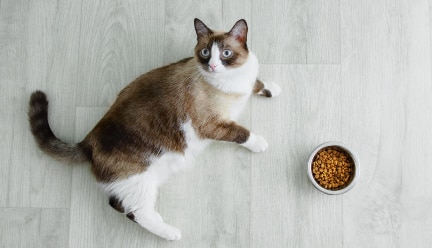
The most common contributing factor to weight gain in cats has been attributed to 'free' or 'ad-lib' feeding. This means leaving food available throughout the day, often in the form of dry kibble. Many pet owners mistakenly believe that cats will self-regulate their food intake, but free-feeding and frequent treats can quickly lead to weight gain, especially when combined with limited physical activity. This is particularly common in indoor cats.
Breed can also play a significant role, according to research from the Swedish University of Agricultural Science,4 which involved more than 2,500 cats. Their study revealed that of all the purebred cats analysed, 50% were overweight, with British Shorthairs the most over-represented, 65% of the breed were assessed as overweight. Maine Coons followed closely behind at 44% and both Birmans and Persians were identified as the least overweight breeds. However, total numbers for purebreds were relatively low in this study, with the majority of cats comprising domestic short/long hair.
The study did find that all male cats are at a higher risk of becoming overweight, accounting for 57% of all overweight cats, and highlighted the disconnect between owner perception versus medical assessment. When body condition score was assessed by trained professionals (via medical records), 47% of all domestic short- and long-haired cats were identified as overweight or obese, but, when pet parents assessed their own domestic short- and long-haired cats (via questionnaire), the figure fell to just 24%.
The link between obesity and health risks.
Sadly, being overweight is not just an aesthetic concern, it significantly increases the risk of various serious health conditions. It is also a condition in its own right, defined as "a systemic, multiorgan, metabolic, chronic and progressive inflammatory disease" of fat cells.5
In Australia, a 2018 study published in the Journal of Small Animal Practice found significant associations between being overweight and 14 specific health conditions in Australian cats. These conditions include diabetes, osteoarthritis and urinary tract disease, all of which are more likely to affect overweight and obese cats than their leaner counterparts. In addition, the study identified, for the first time, associations of high body condition scores with asthma, hypertension, diarrhoea, skin, eye and allergic conditions in cats.
1. Diabetes mellitus.
Overweight and obese body conditions are a major risk factor for diabetes mellitus in cats. Excess fat contributes to insulin resistance, where the body doesn't respond appropriately to insulin, and this leads to elevated blood sugar levels, which in turn can result in Type 2 diabetes. Without appropriate treatment, diabetes can lead to severe and potentially life-threatening complications, such as diabetic ketoacidosis, neuropathy and chronic kidney disease, as well as a reduced lifespan.
In Australia, there is a well-documented link between Australian-bred Burmese cats and the incidence of Type 2 diabetes, which is four times higher than Burmese cats bred in the United States6 and four times the incidence of diabetes in the more common domestic short- and long-haired cat in Australia.7
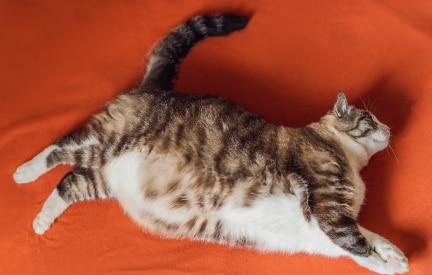
2. Arthritis and joint problems.
Obesity also accelerates the development of osteoarthritis in cats. This condition is characterised by the erosion of joint cartilage, and extra weight in the body puts additional stress on these joints, exacerbating inflammation and pain. The 2018 study from the University of Sydney8 showed that obese cats with a body condition score of eight or above were significantly more likely to suffer from arthritis and other joint-related conditions than their slimmer counterparts, which in turn reduces their mobility and affects their quality of life.
This is backed up by a newly published study in BMC Veterinary Research,9 which found that overweight cats were significantly more likely to suffer from whole body arthritis, with the joints of the wrist, elbow, hip and knees at particular risk.
3. Heart disease.
Hypertrophic cardiomyopathy (HCM) is the most common feline heart disease, making up 60% of all heart conditions in cats.10 However, studies show that obesity doesn't seem to have a strong link to the development of HCM in cats. Fat factors such as body weight and body condition score (BCS) don't appear to have any significant impact. In addition, unlike humans, obese cats with high blood levels of very-low-density lipoprotein (VLDL) fats don't develop high blood pressure or artery disease.11 So, although obesity itself isn't a risk factor for heart disease, one study found that cats with heart failure who were heavier than their more moderate bodyweight counterparts, had a lower survival rate.12
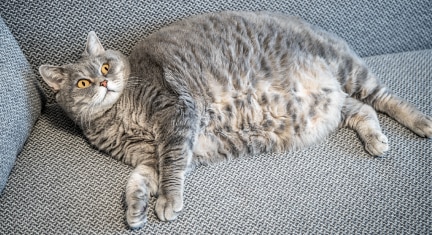
4. Liver disease.
Hepatic lipidosis, commonly known as fatty liver disease, is a common condition in overweight and obese cats, especially when they experience rapid weight loss or prolonged periods of anorexia. It can be triggered by a number of factors including stress, illness or painful underlying diseases, such as pancreatitis.13 Following a period of fasting, the cat's liver begins to break down fat from the body in order to obtain sufficient energy and nutrients for survival. In overweight or obese cats, the excessive fat content can overwhelm the liver's ability to process it, leading to a significant levels of fat accumulation in the liver. A definitive diagnosis often requires a liver biopsy and treatment may require surgical placement of a feeding tube.
5. Urinary tract disorders.
Obesity in cats has been linked to a variety of urinary tract issues, including bladder stones, urolithiasis, lower urinary tract disease (LUTD) and cystitis. Research has indicated that obese cats may be more likely to develop bladder stones because they tend to drink less water and eat more ore-forming minerals that contribute to stone formation.14,15 Additionally, indoor and neutered cats usually drink less, are less active and produce less urine. As a result, urine stays in the bladder longer increasing the risk of bladder stones and urinary tract infections.
Recognising obesity in cats.
As veterinarians and pet parents, it is essential to identify obesity early in its progression to prevent long-term health issues. A simple body condition score (BCS) assessment can help determine whether a cat is overweight or obese.16
Managing obesity: prevention and treatment.
Managing obesity in cats requires a multifaceted approach.
Diet.
Switching to a high-protein, low-carbohydrate diet and ensuring appropriate portion control are fundamental. Reducing calorie intake, especially from treats, and stopping free feeding are also important.
Exercise.
Encourage play and physical activity with interactive toys, puzzle feeders, or even leash training to get your cat moving.
Veterinary guidance.
Regular vet visits are crucial for monitoring weight, adjusting diets, and addressing any emerging health problems early.
Obesity is not just a cosmetic concern, it's a serious medical condition with far-reaching consequences for a cat's health. From diabetes and arthritis to liver disease and urinary problems, obesity contributes to a wide array of conditions that can significantly impact a cat's lifespan and quality of life. In Australia, the statistics are clear: obesity is a growing problem. But with early intervention and proper weight management, we can improve the health and longevity of our feline companions.
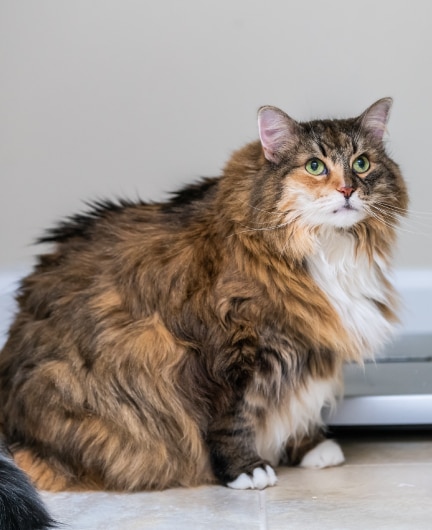
Feline obesity rates escalate with age.
From 17% in first year to 53% by ages 6-7.
Underweight (10% less body fat).
Easily felt bones.
Lack of muscle.
Excessive tummy tuck.
Ideal weight (0%+ extra body fat).
Visible ribs.
Visible waist.
Ribs easy to feel.
Visible slight tummy tuck.
Overweight (10-20% extra body fat) .
Undefined waist.
Broad back.
Press to feel ribs.
Round and saggy abdomen.
Obese (20%+ extra body fat).
Visible fat on neck.
Visible fat on limbs.
Concealed ribs.
No visible waist.
How Everyday Pet Insurance can help.
Unexpected vet bills can be stressful. Pet Insurance can help cover the costs of diagnosis, treatment, and medication for various health conditions.
Here are some benefits you can enjoy with your Everyday Pet Insurance policy:
Other articles you might like.
Help protect your loyal companion and get 10% off an in-store Woolworths shop every month°
Animal Medicines Australia (AMA). (2021). Pets in Australia: A national survey of pets and people. Animal Medicines Australia.
Association for Pet Obesity Prevention (APOP). (2022). State of U.S. Pet Obesity report: Moving from awareness to treatment. Association for Pet Obesity Prevention. Retrieved from https://petobesityprevention.org.
Saavedra, C., Pérez, C., Oyarzún, C., & Torres-Arévalo, A. (2024). Overweight and obesity in domestic cats: Epidemiological risk factors and associated pathologies. Journal of Feline Medicine and Surgery, 26(3), Article 1098612X241285319.
Cornell Feline Health Center. (n.d.). Obesity. Cornell University, College of Veterinary Medicine. Retrieved March 27, 2025, from https://www.vet.cornell.edu/departments/feline-health-center/feline-health-topics/health-information/feline-health-topics/obesity.
Öhlund, M., Palmgren, M., & Höist, B. (2018). Overweight in adult cats: A cross-sectional study. Acta Veterinaria Scandinavica, 60, Article 35.
Teng, K. T., McGreevy, P. D., Toribio, J. A. L. M. L., Raubenheimer, D., Kendall, K., & Dhondt, N. K. (2018). Associations of body condition score with health concessions related to overweight and obesity in cats. Journal of Small Animal Practice, 59(10), 603-613.
Rand, J. S., Farrow, L. M., Farrow, H. A., Appleton, D. L., & Lederer, R. (2004). Canine and feline diabetes mellitus: Nature or nurture? The Journal of Nutrition, 134(8 Suppl), 2072S-2080S.
Lederer, R., Rand, J. S., Jonsson, N. N., Hughes, J. P., & Morton, J. M. (2009). Frequency of feline diabetes mellitus and breed predisposition in domestic cats in Australia. The Veterinary Journal, 179(2), 254-258.
Ley, C. J., Strage, E. M., Stidig, S. M., & von Brömssen, C. (2005). Associations between body composition, metabolic mediators, and osteoarthritis in cats. BMC Veterinary Research, 2(11), 4136.
Chandler, M. L. (2013). Impact of obesity on cardiopulmonary disease. Veterinary Clinics of North America: Small Animal Practice, 43(4), 817-830.
Jordan, E., Kley, S., Le, N. A., & Others. (2008). Dyslipidemia in obese cats. Domestic Animal Endocrinology, 35(3), 290-299.
Finn, E., Freeman, L. M., Rush, J. E., & Others. (2010). The relationship between body weight, body condition, and survival in cats with heart failure. Journal of Veterinary Internal Medicine, 24(5), 1432-1437.
University of Illinois College of Veterinary Medicine. (n.d.). Hepatic lipidosis: When cats don't eat. Veterinary Medicine at Illinois. Retrieved March 27, 2025, from https://vetmed.illinois.edu/pet-health-columns/hepatic-lipidosis-when-cats-dont-eat/
Lekcharoensuk C, Osborne CA, Lulich JP, Puooenthonthum R, Kirk CA, Ulrich LK, Koehler LA, Carpenter KA, Swanson LL. Association between dietary factors and calcium oxalate and magnesium ammonium phosphate urolithiasis in cats. J Am Vet Med Assoc. 2001 Nov 1;219(9):1228-37. doi: 10.2460/javma.2001.219.1228.
Buckley CM, Hawthorne A, Colyer A, Stevenson AE. Effect of dietary water intake on urinary output, specific gravity and relative supersaturation for calcium oxalate and struvite in the cat. Br J Nutr. 2011 Oct;106 Suppl 1:S128-30. doi: 10.1017/S0007114511005175.
World Small Animal Veterinary Association (WSAVA). (2020). Body condition score - Cat (updated August 2020). WSAVA Global Nutrition Committee. Retrieved March 27, 2025, from https://wsava.org/wp-content/uploads/2020/08/Body-Condition-Score-cat-updated-August-2020.pdf
- text
-
† Offer available to new Everyday Pet Insurance policyholders, and is limited to 1 membership per eligible policy. The free membership offer (valued at $199p.a) is from the date of your policy commencement, provided your Everyday Pet Insurance policy remains active. You are not eligible to redeem the free membership subscription for cash or credit. VetAssist is a separate subscription based service to the Everyday Pet Insurance product, and is provided independently by Everyday Insurance third party service provider, VetChat Services Pty Ltd (VetChat). Click here for full VetAssist Service terms and conditions. Everyday Insurance reserves the right to vary or remove this offer at any time and will provide reasonable notice of any such changes.
- text
-
= The gap is defined as the difference between the vet's invoice and the claim benefit under your policy. Policy terms and conditions apply. GapOnly® is only available at participating Vets. Please visit GapOnly® to search for GapOnly® enabled vets. GapOnly® is a trademark owned by PetSure (Australia) Pty Ltd (PetSure) (ABN 95 075 949 923, AFSL 420183).
- text
-
** Offer is valid until 1 July 2026 (Offer Period). This entitles you to a 30% discount off your prescription medication purchase from PetScripts Pty Ltd ABN 73 610 444 427 (PetScripts) whilst your policy remains in force during the Offer Period and cannot be used in conjunction with any other offer. This offer only applies to medication prescribed to the pet insured under Everyday Pet Insurance Policies. Services provided by PetScripts are separate to your pet insurance policy. The 30% discount offer is subject to PetScripts' general Terms and Conditions, including the Privacy Policy which are available online at www.petscripts.com.au. Everyday Pet Insurance may withdraw or extend this offer at any time without notice.
- text
-
Everyday Pet Insurance policies entered into for the first time prior to 17 July 2023 and subsequent renewals of those policies are issued by The Hollard Insurance Company Pty Ltd ABN 78 090 584 473, AFSL 241436 (Hollard), arranged and administered by PetSure (Australia) Pty Ltd ABN 95 075 949 923, AFSL 420183 (PetSure) and promoted and distributed by Hollard’s Authorised Representative (AR) Woolworths Group Limited ABN 88 000 014 675, AR 245476 (Woolworths). Everyday Pet Insurance policies entered into for the first time on or after 17 July 2023 and subsequent renewals of those policies are issued by PetSure and promoted and distributed by PetSure’s AR, Woolworths. Any advice provided is general only and does not take into account your individual objectives, financial situation or needs. Please consider the Product Disclosure Statement (PDS) to ensure this product meets your needs before purchasing, or choosing to continue with the product. PDS and Target Market Determination available at insurance.everyday.com.au/pet-insurance.
